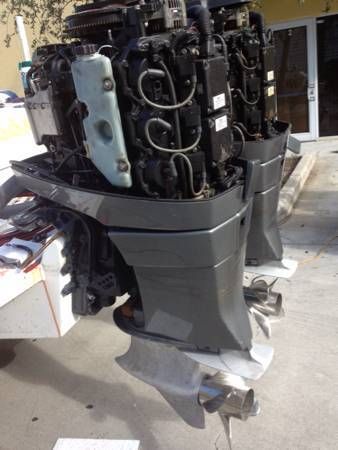

Houseboats almost always use at least one outboard motor with at least 50 horsepower, though 150 to 300 horsepower models are most common. Outboard motors come in many shapes and sizes with various power outputs. They are usually powered by gasoline and mounted partially above and partially below the waterline at the back of the boat. Outboard motors are self-contained propulsion units. Outboard motors are low-maintenance and extremely common on houseboats. Diesel engines are found on larger houseboats, as they’re more powerful for their size and much more fuel-efficient. Gasoline is the most common fuel source for small houseboats, as gasoline engines are much lighter and simpler than diesel engines. Other types of engines found on other boats (such as coal or heavy fuel oil-fired steam plants) are never found aboard houseboats due to their excessive size, weight, and complexity. This simplifies the fueling process and provides a reliable source of fuel for all power plants aboard the vessel. Usually, the generator and propulsion engine aboard a houseboat run on the same fuel, and there’s typically a single fuel tank (or system of connected fuel tanks) that runs both. Gasoline and diesel are by far the most common fuels used by all types of houseboat motors. Generating engines run quietly and are designed to run at constant speeds for sustained periods. The primary purpose of generating engines is to produce electricity to charge a houseboat’s battery bank and to run appliances. These engines are generally more efficient and quieter than propulsion engines, and they consume much less fuel. Generating engines, or generators, serve an entirely different purpose. Propulsion engines allow the boat to move under its own power, both forward and in reverse. The first and most common is a propulsion engine, which rotates a shaft and a propeller. There are two primary kinds of engines (or motors) found aboard houseboats. Cruising houseboats are found most often in rivers, lakes, and other protected waterways. Cruising houseboats are the most numerous for both rental and living aboard. These are also called cruising houseboats, as they’re designed to move along under their own power in both forward and reverse. The majority of houseboats come with engines of some kind. These houseboats can be found in many parts of the country, such as the southern and central marsh areas of San Francisco Bay. Stationary houseboats can be found in canals and rivers in small neighborhoods, usually occupied entirely by vessels of this type. Today, most of the original shanty boats are gone. These were known colloquially as ‘shanty boats.’ The most notable examples of stationary houseboats were used on the Mississippi River during and around the time of the Great Depression.

These types of houseboats are usually custom-made by their owners, and they were once common in many parts of the country. Their materials and construction methods closely mimic traditional houses, with one key exception-they’re built on top of a steel barge or pontoons. Stationary houseboats are usually just houses built on floating foundations. We refer to these as ‘stationary’ or ‘permanent’ houseboats. These are not the majority of houseboats, but they make up a notable segment of the total houseboat numbers.

Some houseboats never came with motors and will never operate under their own power. This is the question we’ll address in this article. When people ask if houseboats have motors, they generally want to know if houseboats have engines and can propel themselves. However, people have used them interchangeably for decades, and we’ll consider them the same thing in this article.Ī motor is technically defined as a machine (generally powered by electricity) that converts one form of energy into rotary mechanical energy.Īn engine consumes fuel (like gasoline or diesel) or the direct product of a fuel (like steam from a coal-burning boiler) and converts it into mechanical energy. Actually, no-motors and engines are not technically the same.


 0 kommentar(er)
0 kommentar(er)
